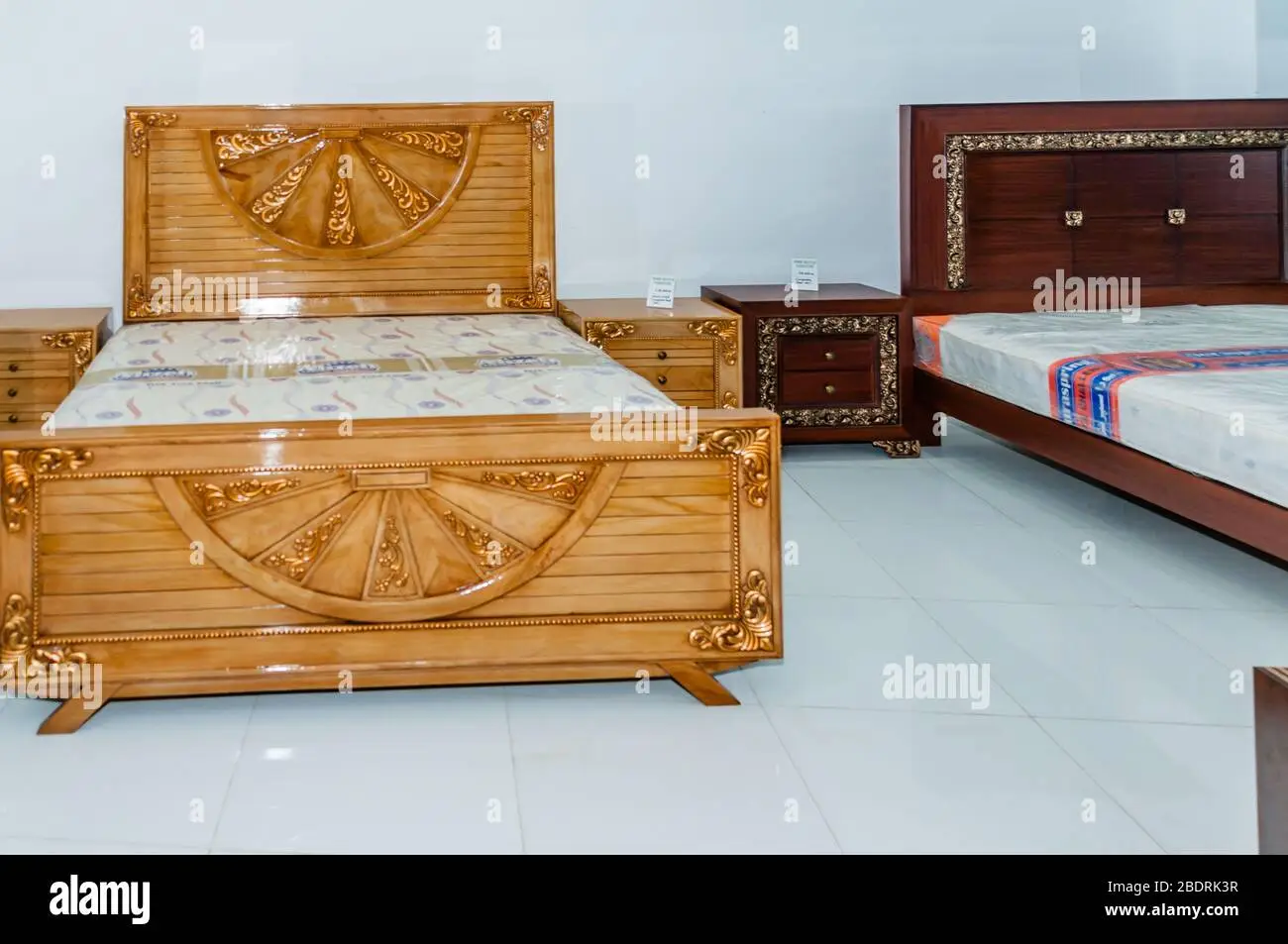Get ready to dive into the fascinating world of Pakistani beds! It’s a journey beyond simple slumber, exploring a rich cultural tapestry woven with tradition, artistry, and warm hospitality. From the iconic charpai to elaborately crafted wooden masterpieces, Pakistani beds offer a glimpse into the heart of the nation’s heritage and evolving design sensibilities.
Bed Culture in Pakistan
In Pakistan, beds hold a unique significance that extends far beyond mere functionality. They represent a harmonious blend of cultural heritage, artistic expression, and social interaction. Unlike the typical Western bedroom setup, Pakistani beds often take center stage in various areas of the home, reflecting their multifaceted role in daily life.
The Charpai: More Than Just a Bed
Imagine a beautifully woven bed, handcrafted with care, sitting comfortably in the courtyard. That’s a charpai, a beloved piece of furniture that’s as much a part of Pakistani culture as chai and biryani. You might hear it called a charpaya, a manja, or even just a khat – but no matter the name, it’s all about that same comfy, traditional vibe.
The name “charpai” literally means “four legs” in Urdu, aptly describing its simple yet sturdy design. It features a rectangular frame held up by four strong legs, with a woven surface typically made from ropes or woven straps. Don’t let its seemingly simplistic construction fool you – these beds are surprisingly comfortable!
A Feast for the Eyes: Pakistani Bed Designs
Step inside a traditional Pakistani home, and you’ll likely encounter a charpai that’s more than just a place to sleep. Think intricate carvings, vibrant colors, and patterns that whisper tales passed down through generations. Each bed is like a piece of art, handcrafted by skilled artisans who pour their heart and soul into every detail.
Welcome Home: The Charpai as a Symbol of Hospitality
In Pakistan, hospitality isn’t just a word – it’s a way of life. And the charpai plays a big role in making guests feel right at home. Often placed in courtyards or verandas, these beds act as comfy gathering spots where friends and family can relax, chat, and enjoy each other’s company. Picture yourself sipping on some chai, feeling the breeze, and sharing stories on a beautiful charpai – that’s the magic of Pakistani hospitality.
Old Meets New: A Blend of Styles
While the traditional charpai still holds a special place in many hearts, Pakistani bed culture is anything but stuck in the past. Today, you’ll find a range of styles, from classic handcrafted pieces to modern designs that seamlessly blend with contemporary décor. It’s all about honoring tradition while embracing the evolving tastes of a new generation.
More Than Meets the Eye: Deeper Meanings
The world of Pakistani beds goes beyond just looks and comfort. Here are a few things to ponder:
- Good for the Earth: Many charpais are made using sustainable materials and traditional techniques, making them an eco-friendly choice in a world that could use more of that.
- Inspiring Global Trends: The unique charm of Pakistani bed designs hasn’t gone unnoticed. Today, you’ll find elements of these styles popping up in homes around the world, adding a touch of handcrafted beauty to modern interiors.
- Bringing People Together: More than just furniture, beds in Pakistan are all about connection. They represent family, community, and the simple joy of spending time with loved ones.
Get inspired by the 3d wallpaper for bedroom price in Pakistan and find the perfect one for your dream home. For those who prefer to dream in their native tongue, check out these dream home quotes in Marathi language.
What Defines Traditional Pakistani Bed Culture?
Traditional Pakistani bed culture is a captivating blend of opulence, artistry, and cultural significance. These beds were more than just places to sleep; they were statements of status, expressions of artistic taste, and cherished heirlooms passed down through generations.
A Legacy of Grandeur:
Historically, wealthy families in Pakistan adorned their homes with majestic beds, often crafted from richly carved wood and embellished with intricate details. These beds, reminiscent of Mughal-era grandeur, featured:
- Intricate Carvings: Skilled artisans would spend months, even years, meticulously carving intricate patterns into the wood. These carvings often depicted floral motifs, geometric designs, and scenes from nature.
- Bold Colors and Embellishments: Vibrant colors and luxurious fabrics played a pivotal role in traditional Pakistani bed design. Rich hues like crimson, emerald green, and sapphire blue were commonly used, often adorned with gold leaf, mirror work, or intricate embroidery.
- Imposing Structures: Traditional Pakistani beds were often massive structures, featuring high headboards, ornate footboards, and sturdy frames. These beds served as the focal point of the bedroom, exuding a sense of grandeur and sophistication.
The Enduring Charm of the Charpai:
While elaborate wooden beds were prevalent among the affluent, the charpai held a special place in the hearts of all Pakistanis. This simple yet versatile bed, typically made from woven ropes or natural fibers stretched over a wooden frame, embodies the essence of Pakistani hospitality and practicality.
The Evolution to Modern Aesthetics:
In contemporary Pakistan, bed designs reflect evolving tastes and preferences, embracing a more minimalist aesthetic while still paying homage to the country’s rich heritage. Modern Pakistani bed designs often feature:
- Clean Lines and Simple Geometry: Sleek, straight lines and geometric shapes have become increasingly popular, reflecting a shift towards modern minimalism.
- Neutral Color Palettes: Contemporary bed designs often incorporate neutral colors like white, beige, gray, and black, creating a sense of serenity and sophistication.
- Fusion of Materials: Modern Pakistani beds experiment with a fusion of materials, combining wood with metal accents, upholstered headboards, and sleek finishes.
How Does Charpai Shape Pakistani Bed Culture?
The charpai‘s influence on Pakistani bed culture extends far beyond its practical use as a sleeping surface. It embodies the nation’s values of hospitality, resourcefulness, and a deep connection to cultural heritage.
A Symbol of Warmth and Welcome:
In Pakistani households, offering a guest a seat on a charpai is a gesture of warmth and respect. It signifies a willingness to share personal space and engage in heartfelt conversation. The charpai transcends its function as a bed, transforming into a symbol of inclusivity and shared experiences.
A Testament to Sustainable Living:
The charpai‘s construction reflects a deep respect for nature and resourcefulness. Traditionally crafted from readily available materials like wood and natural fibers, the charpai embodies sustainable living practices. Its simple design allows for easy disassembly and transportation, making it an ideal choice for nomadic communities and those seeking eco-friendly furniture options.
A Canvas for Artistic Expression:
While the basic structure of the charpai remains consistent, its woven surface provides a canvas for artistic expression. Skilled artisans create intricate patterns and designs using colorful ropes and threads, showcasing the diversity of regional craftsmanship and aesthetic sensibilities.
Exploring Regional Bed Designs in Pakistan
Pakistan’s diverse regional landscape is reflected in its bed designs, each area showcasing unique craftsmanship and artistic traditions.
Punjab: Where Majesty Meets Vibrancy
- Key Features: Intricately carved wood, bold colors, symmetrical layouts, geometric patterns.
- Inspiration: Mughal architecture and a penchant for grandeur.
Sindh: A Tapestry of Stories and Shimmer
- Key Features: Bright embroidery, mirror work, shimmering fabrics, intricate patterns passed down through generations.
- Inspiration: Rich textile traditions and a love for vibrant embellishments.
Khyber Pakhtunkhwa: Bold Beauty from the Mountains
- Key Features: Bold decorations, rich fabrics, inspiration from tribal art and the region’s natural beauty.
- Inspiration: Rugged landscapes and the strong spirit of its people.
Baluchistan: Earthy Elegance and Nomadic Roots
- Key Features: Handwoven fabrics, earthy colors, simple yet elegant designs.
- Inspiration: Nomadic traditions, a deep connection to nature, and resourcefulness.
Making Your Dream Bed a Reality
One of the most remarkable aspects of Pakistani bed design is the ability to customize. Skilled artisans are ready to bring your vision to life, whether you’re drawn to the charm of a traditional charpai or a modern masterpiece. From budget-friendly options to luxurious splurges, there’s something for everyone.
Sustainability: Crafting a Greener Future
Pakistani designers are increasingly embracing eco-friendly materials and ethical production methods, ensuring these beautiful traditions continue to thrive while protecting the planet.
A Celebration of Craftsmanship and Culture
More than just furniture, Pakistani beds offer a window into the soul of the nation. From time-honored designs to fresh, contemporary takes, they embody the beautiful marriage of tradition and innovation. Whether you’re seeking a piece that reflects your heritage or a statement piece that sparks conversation, Pakistani bed designs offer a captivating blend of artistry and craftsmanship.
- Does Ammonia Kill Mold? The Truth About Using It for Removal - April 15, 2025
- Does Bleach Kill Spiders? Effectiveness, Safety, and Better Alternatives - April 15, 2025
- Does Soap Expire? How to Tell if Your Soap Has Gone Bad - April 15, 2025










